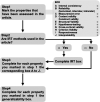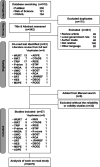Reliability and validity of on-road driving tests in vulnerable adults: a systematic review
- PMID: 31469673
- PMCID: PMC7597760
- DOI: 10.1097/MRR.0000000000000374
Reliability and validity of on-road driving tests in vulnerable adults: a systematic review
Abstract
The on-road driving test is considered a 'gold standard' evaluation; however, its validity and reliability have not been sufficiently reviewed. This systematic review aimed to map out and synthesize literature regarding on-road driving tests using the Consensus-based Standards for the Selection of Health Measurement Instruments checklist. Cochrane Library, PubMed, CINAHL, and Web of Science databases were searched from initiation through February 2018. All articles addressing reliability or validity of on-road driving tests involving adult rehabilitation patients were included. The search output identified 513 studies and 36 articles, which were included in the review. The Washington University Road Test/Rhode Island Road Test, performance analysis of driving ability, test ride for investigating practical fitness-to-drive, and K-score demonstrated high reliability and validity in regard to the Consensus-based Standards for the Selection of Health Measurement Instruments checklist. The Washington University Road Test/Rhode Island Road Test and test ride for investigating practical fitness-to-drive were analyzed based on Classical Test Theory techniques, and performance analysis of driving ability and K-score were analyzed based on Item Response Theory techniques. The frequency of studies were Washington University Road Test/Rhode Island Road Test (n=9), Test Ride for Investigating Practical fitness-to-drive (n=8), performance analysis of driving ability (n=4), and K-score (n=1). From the viewpoint of accuracy and generalization, the Washington University Road Test/Rhode Island Road Test, test ride for investigating practical fitness-to-drive, and performance analysis of driving ability were identified as highly qualified concerning on-road driving tests. However, the ability to assess real-world driving depends on various environmental conditions.
Figures


Similar articles
-
Standardized on-road tests assessing fitness-to-drive in people with cognitive impairments: A systematic review.PLoS One. 2020 May 18;15(5):e0233125. doi: 10.1371/journal.pone.0233125. eCollection 2020. PLoS One. 2020. PMID: 32421733 Free PMC article.
-
Performance Analysis of Driving Ability (P-Drive): Investigating Construct Validity and Concordance of Australasian Data.OTJR (Thorofare N J). 2025 Jan;45(1):95-104. doi: 10.1177/15394492231221960. Epub 2024 Jan 25. OTJR (Thorofare N J). 2025. PMID: 38268445 Free PMC article.
-
On-road assessment of driving competence after brain impairment: review of current practice and recommendations for a standardized examination.Arch Phys Med Rehabil. 1998 Oct;79(10):1288-96. doi: 10.1016/s0003-9993(98)90277-5. Arch Phys Med Rehabil. 1998. PMID: 9779686 Review.
-
Test acceptability and confidence levels in older adults referred for fitness-to-drive evaluations.Am J Occup Ther. 2010 Mar-Apr;64(2):252-8. doi: 10.5014/ajot.64.2.252. Am J Occup Ther. 2010. PMID: 20437912
-
Assessing fitness to drive-A validation study on patients with mild cognitive impairment.Traffic Inj Prev. 2017 Feb 17;18(2):145-149. doi: 10.1080/15389588.2016.1232809. Epub 2016 Sep 13. Traffic Inj Prev. 2017. PMID: 27623685
Cited by
-
Evaluation of Psychophysical Fitness in Drivers over 65 Years of Age.Healthcare (Basel). 2023 Jul 3;11(13):1927. doi: 10.3390/healthcare11131927. Healthcare (Basel). 2023. PMID: 37444761 Free PMC article.
-
Driving assessment in preclinical Alzheimer's disease: progress to date and the path forward.Alzheimers Res Ther. 2022 Nov 8;14(1):168. doi: 10.1186/s13195-022-01109-1. Alzheimers Res Ther. 2022. PMID: 36348410 Free PMC article. Review.
-
Self-awareness predicts fitness to drive among adults referred to occupational therapy evaluation.Front Rehabil Sci. 2022 Nov 16;3:1005025. doi: 10.3389/fresc.2022.1005025. eCollection 2022. Front Rehabil Sci. 2022. PMID: 36466937 Free PMC article.
-
Standardized on-road tests assessing fitness-to-drive in people with cognitive impairments: A systematic review.PLoS One. 2020 May 18;15(5):e0233125. doi: 10.1371/journal.pone.0233125. eCollection 2020. PLoS One. 2020. PMID: 32421733 Free PMC article.
-
Performance Analysis of Driving Ability (P-Drive): Investigating Construct Validity and Concordance of Australasian Data.OTJR (Thorofare N J). 2025 Jan;45(1):95-104. doi: 10.1177/15394492231221960. Epub 2024 Jan 25. OTJR (Thorofare N J). 2025. PMID: 38268445 Free PMC article.
References
-
- Akinwuntan AE, Feys H, De Weerdt W, Baten G, Arno P, Kiekens C. Prediction of driving after stroke: a prospective study. Neurorehabil Neural Repair. 2006; 20:417–423 - PubMed
-
- Bliokas V V, Taylor JE, Leung J, Deane FP. Neuropsychological assessment of fitness to drive following acquired cognitive impairment. Brain Inj. 2011; 25:471–487 - PubMed
-
- Brooke MM, Questad KA, Patterson DR, Valois TA. Driving evaluation after traumatic brain injury. Am J Phys Med Rehabil. 1992; 71:177–182 - PubMed
Publication types
MeSH terms
LinkOut - more resources
Full Text Sources
Medical

